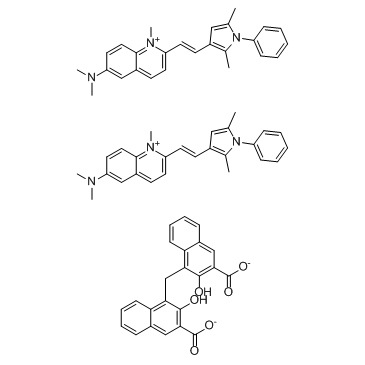| Description |
Pyrvinium pamoate is an FDA-approved antihelmintic drug that inhibits WNT pathway signaling.
|
| Related Catalog |
|
| In Vitro |
Pyrvinium pamoate (0-500 nM) inhibits proliferation of MCF-7 (luminal), MDA-MB-231 (claudin-low), MDA-MB-468 (basal-like) and SkBr3 (HER2-OE) cells in a dose-dependent manner, with IC50 value of 1170±105.0 nM against MDA-MB-231 cell line. Pyrvinium pamoate significantly inhibits self-renewal and proliferation of BCSCs, and suppresses BCSC population with a distinct phenotype. Pyrvinium pamoate significantly decreases average expression levels of FZD1, FZD10, WNT1, WNT7B, CTNNB1, MYC, and LRP5 at transcriptional level. Moreover, Pyrvinium pamoate also efficiently down-regulates the expression of other stemness genes including ALDH1, CD44 and ABCG2[1]. Pyrvinium pamoate blocks colon cancer cell growth in vitro in a dose-dependent manner with great differences in the inhibitory concentration (IC50), ranging from 0.6 to 65 μM for colon cancer cells with mutations in WNT signaling. Pyrvinium pamoate decreases messenger RNA (mRNA) and protein levels of known WNT target genes as c-MYC and thereby led to the induction of p21[2]. Pyrvinium pamoate ultimately inhibits Wnt signalling despite its lack of efficacy on CK1[3]. Pyrvinium pamoate imposes specific toxicity on cardiac fibroblasts in ischemia (IC50=9.5 nM). The cytotoxic effect of Pyrvinium pamoate on cardiac fibroblasts specifically under glucose- and glutamine-deficient condition[4].
|
| In Vivo |
In the xenograft model, Pyrvinium pamoate (500 nM)-pretreatment strongly delays tumor size and tumor weight, and the tumor volume is markedly decreased[1].
|
| Cell Assay |
Pyrvinium pamoate is dissolved in DMSO at a concentration of 1 μM and is stocked in aliquots at -20°C. Cells (1×104) are suspended in 200 μL culture medium and then seeded into 96-well plates in quintuplicate overnight. Cells are treated with indicated concentrations of Pyrvinium pamoate (0-8,000 μM). After incubating for 3 days, CCK8 (10 μL) is added into each well and incubated at 37°C for 1 h. The absorbance is measured using a microplate reader at 450 nm[1].
|
| Animal Admin |
Mice: NOD/SCID mice are housed under aseptic conditions in individually ventilated cages. For xenografting, 5×106 Pyrvinium pamoate-pretreated or untreated breast cancer cells (MDA-MB-231) are resuspended in a 1:1 mixture of culture medium and Matrigel and then transplanted into the fourth pair of mammary fat pads of mice (4-6-week-old). After injection, tumor size is measured by calipers each day and tumor growth is plotted. Upon reaching the endpoint, mice are sacrificed and tumors are harvested. All the tumors are formalin-fixed, and paraffin-embedded for hematoxylin and eosin and immunohistochemical staining[1].
|
| References |
[1]. Xu L, et al. WNT pathway inhibitor pyrvinium pamoate inhibits the self-renewal and metastasis of breast cancer stem cells. Int J Oncol. 2016 Mar;48(3):1175-86. [2]. Wiegering A, et al. The impact of pyrvinium pamoate on colon cancer cell viability. Int J Colorectal Dis. 2014 Oct;29(10):1189-98. [3]. Venerando A, et al. Pyrvinium pamoate does not activate protein kinase CK1, but promotes Akt/PKB down-regulation and GSK3 activation. Biochem J. 2013 May 15;452(1):131-7. [4]. Murakoshi M, et al. An anthelmintic drug, pyrvinium pamoate, thwarts fibrosis and ameliorates myocardial contractile dysfunction in a mouse model of myocardial infarction. PLoS One. 2013 Nov 4;8(11):e79374.
|


